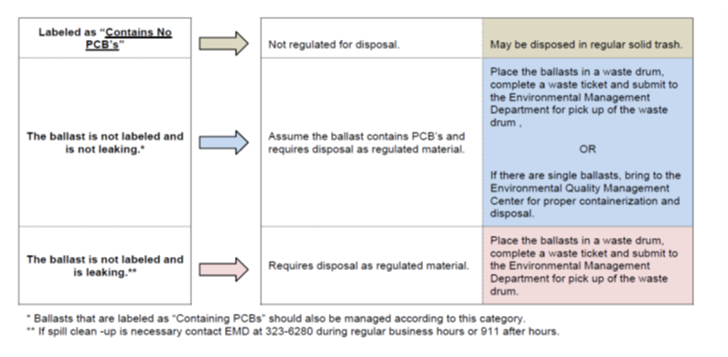PCB Containing Equipment, Materials & Chemicals
As summarized in the Environmental Management Guide for Educational Facilities (2017, Published by APPA and CSHEMA), EPA banned the commercial production of polychlorinated biphenyls (PCBs) in 1979, citing health and environmental concerns. PCBs have been identified as probable human carcinogens and cause a variety of non-cancer health effects as well.2 Due to their inherent properties including nonflammability, chemical stability and electrical insulating, PCBs were used in hundreds of industrial and commercial applications including:
- Electrical equipment
- Surface coatings
- Inks
- Adhesives
- Flame-retardants
- Paints
Again from the aforementioned Guide book one can expect to encounter PCBs in the following:
- Buildings built or renovated between 1949 and 1979 may contain PCBs in caulking, glazing compounds, adhesives and other materials.
- Oil-containing device manufactured prior to 1979 and examples include transformers, capacitors, electrical equipment including voltage regulators, re-closers, bushings and electromagnets, oil used in motors and hydraulic systems, lab equipment or appliances and air compressors.
- Chemicals used in laboratories for research,
- Fluorescent light ballasts there were manufactured before January 1, 1978 and not marked “NO PCBs”.
PCBs are not regulated as a hazardous waste but instead are regulated through a specific federal law known as the Toxic Substances Control Act (TSCA). Understanding the regulatory standards of TSCA can be difficult and assistance is available from Environmental Quality Management Department (EQM) but three distinct occurrences of PCBs at UK are described further below.
1 – 2017, Published by APPA and CSHEMA
2 - https://www.epa.gov/pcbs/learn-about-polychlorinated-biphenyls-pcbs#healtheffects
PCB Containing Equipment
The most common example of PCB containing equipment are fluorescent light ballasts, though as mentioned above there is other equipment that may be encountered. EPA has produced a PCBs in Fluorescent Light Ballasts Fact Sheet that summarizes many of the important issues surrounding the management of such equipment. Additionally, provided below is a summary of the different PCB management scenarios at UK involving light ballasts

- Only properly trained maintenance personnel may change fluorescent light ballasts. The ballasts should be placed into drums supplied by EQM. The drums must be labeled as “Light Ballasts –Contains PCB’s” and stored on-site until they are full.
- Maintenance personnel should complete a waste ticket and submit to EQM when containers are full to arrange pickup.
- Single ballasts resulting from maintenance work may be brought to the Environmental Quality Management Center, 355 Cooper Drive, for proper containerization and disposal.
- All UK personnel (and their supervisors) who handle fluorescent light ballasts must be trained.
- The EQM will prepare the accumulated PCB containing waste for proper shipment, manifesting, and disposal through UK’s waste management contractor.
PCB Containing Materials
Manufactured PCB products are materials that were made with PCBs and are in a non-liquid state. EPA has produced a PCBs in Building Materials Fact Sheet that addresses PCB products that may be found throughout some buildings or on some structures. An example of PCB containing materials that have been encountered on buildings and structures at UK is caulking used around windows and within expansion joints. Whether its caulk or some other building material that has the possibility of containing PCBs, before any building maintenance, demolition or other activities that may disturb the suspect materials are undertaken you should contact EQM for assistance and possible confirmatory sampling and analysis. There is no visual standard for determining the presence of PCBs so only laboratory analysis can provide a confirmatory determination If PCBs are determined to be present there are regulatory requirements that must be addressed.
If I have questions, what should I do?
Contact: Tommy Taylor
Sr. Environmental Specialist
859-257-5295
twtayl0@uky.edu
PCB Containing Chemicals
The cutting-edge research on-going at UK necessitates that a wide variety of chemicals may be used on any given day of operation. Some of these chemicals may be comprised in their entirety or in part of PCBs. The management of PCB containing chemicals as waste should follow the same procedures as explained in Waste Pick-Up Requests (E-Trax). While PCBs themselves are not regulated as a hazardous waste their use in research often results in the generation of a mixed waste containing both PCBs and other chemicals that are regulated as hazardous and, therefore, the hazardous waste regulatory labeling and management requirements as explained in Hazardous Waste Management Basics would apply.
If I have questions, what should I do?
Contact: Maridely Loyselle
Assistant Director
859-562-3121
maridely.loyselle@uky.edu
